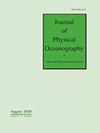全球深海动能传输观测
IF 2.8
2区 地球科学
Q1 OCEANOGRAPHY
引用次数: 1
摘要
通过对 Argo 深层位移(位于 950 和 1150 dbar 之间)及其相关的拉格朗日综合速度的观测,可以首次计算出 3°×3°-平均库和涡库(分别为 MKE 和 EKE)之间动能(KE)的全球深层水平转移。这一分析表明,这些转移主要集中在西部边界和南大洋。总体而言,MKE 向 EKE 的转移在全球和所有具体测试区域(即湾流、黑潮、阿古哈斯洋流和南极环极洋流)都占主导地位。然而,扎皮奥拉回旋是一个重要的例外,在那里,EKE 向 MKE 的传输占主导地位。除此之外,我们还发现,平均流变形的水平特性(发散和应变)比湍流速度的水平特性更能描述水平 KE 转移。我们的理论分析还表明,平均流涡度对 KE 转移没有贡献。我们证明存在两种一致的转移模式:一种是从 MKE 到 EKE,另一种是从 EKE 到 MKE,它们都是基于平均流变形张量的特征向量。湍流沿这些方向的排列选择了转移模式,而正是这两种转移模式之间的竞争导致了实际的转移。我们计算了全球、区域和局部的这些转移模式。我们通过湍流与 EKE 到 MKE 转移模式的有利排列来解释扎皮奥拉回旋的独特情况。总之,大尺度流动特性对 MKE 到 EKE 转移结构的主导作用表明,大尺度参数化具有潜力。本文章由计算机程序翻译,如有差异,请以英文原文为准。
Global Observations of Deep Ocean Kinetic Energy Transfers
Observations of deep Argo displacements (located between 950 and 1150 dbar) and their associated integrated Lagrangian velocities allow for the first time to compute worldwide deep horizontal transfers of Kinetic Energy (KE) between the 3°×3°-Mean and the Eddy reservoirs (MKE and EKE, respectively). This diagnostic reveals that the transfers are mainly localized along western boundaries and in the Southern Ocean. Overall the MKE-to-EKE transfers appear dominant globally and in all specifically tested regions (i.e., Gulf Stream, Kuroshio, Agulhas Current, and Antarctic Circumpolar Current). However an important exception is the Zapiola gyre where the EKE-to-MKE transfers dominate. Beyond that, we find that horizontal KE transfers are better described by the horizontal properties of the mean flow deformation (divergence and strain) than by the horizontal properties of the turbulent velocities. Our theoretical analysis also demonstrates that the mean flow vorticity does not contribute to KE transfers. We show the existence of two consistent transfer modes: one from MKE to EKE and one from EKE to MKE, which are based on the eigendirections of the mean flow deformation tensor. The alignment of the turbulence along these directions selects the transfer modes and it is the competition between these two transfer modes that leads to the actual transfers. We compute these transfer modes globally, regionally, and locally. We explain the distinctive situation of the Zapiola gyre by the favoured alignment of the turbulence with the EKE-to-MKE transfer mode. Overall, the dominance of the large-scale flow properties on the structure of the MKE-to-EKE transfers suggests the potential for a large-scale parameterization.
求助全文
通过发布文献求助,成功后即可免费获取论文全文。
去求助
来源期刊
CiteScore
2.40
自引率
20.00%
发文量
200
审稿时长
4.5 months
期刊介绍:
The Journal of Physical Oceanography (JPO) (ISSN: 0022-3670; eISSN: 1520-0485) publishes research related to the physics of the ocean and to processes operating at its boundaries. Observational, theoretical, and modeling studies are all welcome, especially those that focus on elucidating specific physical processes. Papers that investigate interactions with other components of the Earth system (e.g., ocean–atmosphere, physical–biological, and physical–chemical interactions) as well as studies of other fluid systems (e.g., lakes and laboratory tanks) are also invited, as long as their focus is on understanding the ocean or its role in the Earth system.

 求助内容:
求助内容: 应助结果提醒方式:
应助结果提醒方式:


